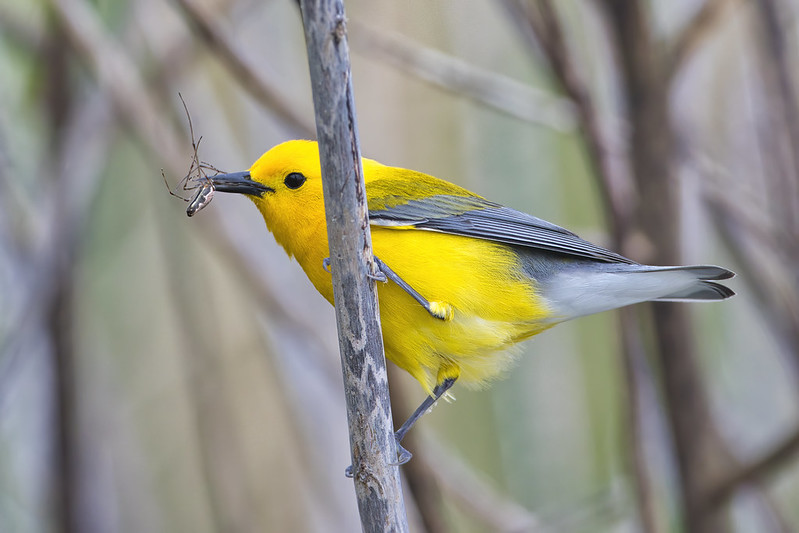Recently, during a visit to the Sequoyah National Wildlife Refuge in Oklahoma, I had the opportunity to capture a fascinating moment in the life of a Prothonotary Warbler. This refuge, known for its diverse ecosystems and abundant wildlife, is one of my favorite locations for photography. On this particular morning, I observed the warbler engaging in a behavior that showcased both its survival instincts and the ecological richness of its environment.
As I sat quietly in my truck, scanning the trees for activity, a flash of yellow caught my eye. It was a Prothonotary Warbler, easily identified by its vibrant yellow plumage and bluish-gray wings. The bird was busily flying in and out of a tree cavity, clearly building a nest. These warblers often nest near water, using natural hollows in trees for protection and access to nearby food sources.

Prothonotary Warbler Feeding Habits and Behavior
What made this moment particularly memorable happened next. The warbler suddenly swooped down near my truck, a spider clenched in its beak. It landed on a nearby branch and quickly consumed the prey. Observing this from such a close distance gave me the chance to photograph the behavior in vivid detail. It’s rare to witness feeding behavior this close—and even rarer to capture it on camera.
Prothonotary Warblers are primarily insectivorous. They forage in swampy woodlands, marsh edges, and riparian forests—habitats rich in invertebrates. Their diet includes beetles, spiders, caterpillars, and other small arthropods, which provide the protein they need, especially during the demanding breeding season.
Interestingly, these birds have also been observed eating snails—a relatively uncommon dietary choice for songbirds. Using their pointed bills, they can crack open the shells to extract the soft tissue inside. This kind of opportunistic feeding behavior highlights their adaptability and resourcefulness in the wild.
Protecting Warbler Habitat: Forest and Wetland Conservation
Watching this warbler in its natural setting reminded me how vital conservation efforts are for species like this. Preserving forests and wetlands ensures birds have access to safe nesting sites and reliable food sources. Places like Sequoyah National Wildlife Refuge play a crucial role in maintaining healthy ecosystems that support a wide range of wildlife.
Wildlife Photography Gear and Camera Settings
To photograph this moment, I used a Canon EOS 7D Mark II paired with a Canon EF 500mm f/4L IS USM lens. To stabilize my camera without disturbing the bird, I placed it on a bean bag resting on my truck’s open window. This setup allowed me to remain unobtrusive while still capturing sharp, detailed images.
Photo Info:
- Date Taken: April 28, 2020
- Time: 7:50 A.M.
- Camera Mode: AV (Aperture Priority)
- Aperture: f/5.6
- ISO: 2000
- Shutter Speed: 1/500 sec
- Exposure Compensation: +4/3
- Focal Length: 500mm
Reflecting on Birdwatching and Wildlife Photography
Experiences like this are what make wildlife photography so rewarding. Each outing offers a chance to witness nature’s quiet drama—from a deer stepping through morning fog to a bird savoring its breakfast. These encounters are powerful reminders to remain curious, patient, and always ready for the next story the natural world has to share.
If you’re interested in seeing more of this species in action, check out my previous posts: Feasting on a Caterpillar and Eating a Dragonfly. These moments also showcase the incredible foraging behaviors of this colorful bird.
